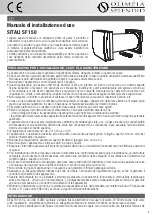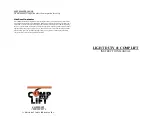
Operating Manual
GML 800+
Glass and Material Lift
GML 800+
45
Loading and Transportation.
Loading while tilting.
Loading by crane.
Before loading, familiarise yourself with the requirements for the loading methods as well as for the
vehicles/trailers for lift transportation. Read and Adhere to the respective conditions.
1.
Tilting
2. Crane
1.
Place the lift in a tilted position ready to be
loaded upon the vehicle for transportation.
2.
Ensure that the mast system is in a lowered
position and properly secured by the mast
element transport safety hook. Examine the
lift for any loose parts and ensure that the
lateral outriggers (if equipped) are secured
and in a folded position.
3.
Ensure that the correct lifting methods are
used to either, load the lift onto the loading
area or load it directly into the transport
vehicle or trailer itself.
4.
Ensure that the safety brakes are Engage on
the casters that are in contact with the
surface of the loading area.
5.
Ensure that the lift is secured properly with
the appropriate belts/chains in order to
avoid any uncontrolled movements or any
possibility of it tipping-over etc. Avoid
damage to any lift components when
securing it.
Unloading:
6.
To unload the lift from its transport position,
loosen the belts/chains and disengage the
safety brakes on the casters.
7.
Push the lift carefully and slowly towards the
edge of the vehicles loading area.
8.
Ensure that the correct lifting methods is
used to unload the lift from the transport
vehicle or trailer directly onto the
ground.
1.
Place the lift in position for transportation
under the hook of the crane.
2.
Ensure that the mast system is in a lowered
position and properly secured by the mast
element transport safety hook. Examine the
lift for any loose parts.
3.
Ensure that the crane has sufficient lifting
capacity.
4.
Ensure that the lifting hook of the crane is
used for the specified hoisting ring of the lift
only. The ring is located on the upper end of
the mast system.
5.
Clip the lifting hook of the crane onto the
hoisting ring of the lift. ensure that it is
securely fastened before the lift is
elevated.
6.
Use the crane to carefully elevate the lift
and position it onto the loading area as
required.
7.
Lower the lift carefully onto the ground and
disconnect the crane from the lift.
8.
Engage the safety brakes on the casters that
are in contact with the surface of the
loading area.
9.
Ensure that the lift is secured properly with
the appropriate belts/chains in order to avoid
any uncontrolled movements or any
possibility of it tipping-over etc. Avoid
damage to any lift components when
securing it.
Unloading:
1.
To unload the lift from its transport position
on the vehicle/trailer, loosen the belts/chains
and then disengage the safety brakes on the
casters.
2.
Push the lift carefully and slowly to a position
whereby it is
unhindered and have safe
access by crane if possible.
3.
Clip the lifting hook of the crane onto the
hoisting ring of the lift. Ensure that it is
securely fastened before the lift is
elevated.
4.
Use the crane to carefully elevate the lift from
the loading area of the vehicle/trailer and set
it slowly down to the ground.
5.
Disconnect the crane from the lift.
WARNING:
> When the lift is being set onto the
ground ensure that you keep a safe
distance from it!
> Ensure that no one remains beneath
the lift while it is being loaded or
unloaded!
WARNING: When the lift is being set onto the
ground ensure that you keep a safe distance from it!
Not to do so,
will increase the likelihood injuries being
incurred.








































